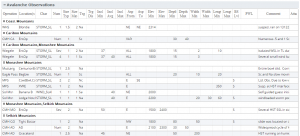Difference between revisions of "Grouping of observations within tables"
Jump to navigation
Jump to search
m (→Background) |
m (→Step-by-step-description) |
||
| Line 26: | Line 26: | ||
|- | |- | ||
|class="StepNum" | Range: | |class="StepNum" | Range: | ||
| − | |This option groups the report entries in each table by the mountain range of the location. | + | |[[File:ReportGroupedbyRange.png|300px|thumb|right|Fig. 3:Example of a report grouped by ''''Range'''']]This option groups the report entries in each table by the mountain range of the location. |
| − | {{note|The mountain range of the location is decided automatically by comparing the location to a baseline map of predefined mountain ranges. If the location overlaps two defined mountain ranges it will be considered to lie in both.}} | + | {{note|The mountain range of the location is decided automatically by comparing the location to a baseline map of predefined mountain ranges. If the location overlaps two defined mountain ranges it will be considered to lie in both.|NoteWithImage}} |
|- | |- | ||
|class="StepNum" | Operation: | |class="StepNum" | Operation: | ||
| − | |This option groups the report entries in each table alphabetically by the operation name. | + | |[[File:ReportGroupedbyOperation.png|300px|thumb|right|Fig. 4:Example of a report grouped by ''''Operation'''']]This option groups the report entries in each table alphabetically by the operation name. |
| − | {{Issue|Currently this sorting method does not sort locations alphabetically and some unexpected ordering can occur| | + | {{Issue|Currently this sorting method does not sort locations alphabetically and some unexpected ordering can occur| IssueWithImage| SAFE-967 | Oct 29, 2013}} |
|- | |- | ||
|class="StepNum" | None: | |class="StepNum" | None: | ||
Revision as of 14:23, 29 October 2013
| REQUIREMENTS | |
| Permission | All user levels |
| Connectivity | Online only |
This page describes how observations may be grouped within reports
Background
Users can group the rows of tables according to three preferences: range; operation; and, no preference.
| NOTE | All tables will have the same grouping order. You cannot group 'Messages' by 'range' and 'Snowpack description' by 'operation', for instance. |
The following information assumes you are logged in to the InfoEx application, you have selected an operation (if you have more than one valid operation) and you have selected 'Reports' on the main application menu.
Step-by-step-description
| 1. | To access the grouping options select the 'settings' icon on the upper right of the 'Reports' page (fig. 1). | ||||||||||
| 2. | A dropdown box will appear offering selections for the layout, grouping, and table types for the report that will be produced (Fig.2). For a description of selecting tables and layout see: Specifying the tables to be included in an InfoEx report and Single page view versus individual tabs for tables. | ||||||||||
| 3. | Under 'Group By' select the grouping option that you prefer. The grouping options will provide output as follows:
|
Related documents
- Specifying the tables to be included in an InfoEx report
- Single page view versus individual tabs for tables
Functionality tested by
- Oct 29: John Kelly / QA Server / Test Version 0.32.00


